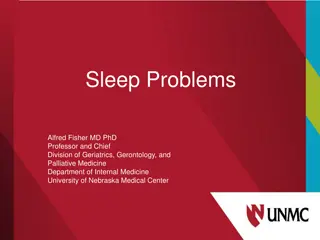Understanding Sleep Studies in Achondroplasia: Which? When? Why? Minutes
There is currently no protocol for screening and managing sleep-disordered breathing in individuals with achondroplasia. This study explores different types of sleep-disordered breathing in both childhood and adulthood, discusses various assessment techniques, evaluates proactive vs reactive management approaches, and outlines therapeutic options and care principles. The workshop attendees agreed on guiding principles for managing sleep-disordered breathing in achondroplasia.
Download Presentation

Please find below an Image/Link to download the presentation.
The content on the website is provided AS IS for your information and personal use only. It may not be sold, licensed, or shared on other websites without obtaining consent from the author. Download presentation by click this link. If you encounter any issues during the download, it is possible that the publisher has removed the file from their server.
E N D
Presentation Transcript
UNDERSTANDING SLEEP STUDIES IN ACHONDROPLASIA: WHICH? WHEN? WHY? MINUTES Tuesday 24th October 2023
Executive Summary There is currently no protocol for screening and managing sleep-disordered breathing in individuals with achondroplasia 100% of live poll respondents agreed that access to appropriate expertise to assess sleep-disordered breathing is essential in centres managing achondroplasia Five guiding principles were developed prior to the workshop; these were presented, discussed, and voted on Attendees largely agreed with the guiding principles, except for one which was reworded There was 100% agreement amongst attendees to pass all guiding principles The mean level of agreement with the principles ranged from 8.9 9.7 (on a scale of 1 10, with 10 being strongly agree)
Attendee Overview Understanding Sleep Studies in Achondroplasia: Which? When? Why? October 2023 Clinical Management Challenges in Infants and Young Children October 2022 Detection and Management of Foramen Magnum Stenosis April 2022 Number of attendees (total) HCP PAG 55 40 2 51 45 6 52 47 5 Number of sponsors attending 13 8 9 Number of countries represented 17 15 17 4
Objectives Describe different types of sleep-disordered breathing that may affect people with achondroplasia (both in childhood and adulthood) Identify the different studies for assessing sleep-disordered breathing, and why/when some techniques are preferable to others Discuss the pros and cons of proactive screening for sleep-disordered breathing vs reactive management based on clinical indications Evaluate therapeutic options for sleep-disordered breathing, and discuss suitable management pathways in this patient population Develop guiding principles of care for sleep-disordered breathing in achondroplasia 5
Agenda Understanding Sleep Studies in Achondroplasia: Which? When? Why? Understanding Sleep-disordered Breathing in Achondroplasia Brigitte Fauroux Which Sleep Study? Josef Milerad Diagnosing Sleep-disordered Breathing: Clinical Indications vs Screening Mieke Boon and N ria Madureira Therapeutic Options for Sleep-disordered Breathing Brigitte Fauroux and Lino Nobili Management of Sleep-disordered Breathing: Interactive Case Study Discussion Mieke Boon and Lino Nobili Summary and Close Brigitte Fauroux 6
GUIDING PRINCIPLES FOR SLEEP-DISORDERED BREATHING
EAF Guiding Principles for Sleep-disordered Breathing Item Guiding Principle Vote (%) Level of agreement (mean; range) Due to the high prevalence of sleep-disordered breathing in individuals with achondroplasia of all ages, and the risk of associated complications, lifelong assessment and proactive management is required A 100% 8.9 (5 10) The type of sleep study required to assess for SDB should be individualised to the age, needs and symptoms of the patient B 100% 8.9 (6 10) Screening for SDB should be undertaken routinely throughout the life course, with particular focus on the early years of life when onset is more common C 100% 9.1 (7 10) If SDB is suspected, a sleep study should be performed, with scoring made by a sleep specialist as soon as possible; interpretation and therapeutic management should be performed within an achondroplasia MDT D 100% 9.5 (7 10) Stepwise therapeutic management should be individualised to the type and severity of SDB and the age of the patient E 100% 9.7 (8 10) 8
Most Respondents Found This Event to be of a High Standard How would you rate the quality of the programme this event? How would you rate the quality of the organisation this event? 3.1% 3.1% 12.5% 12.5% 84.4% 84.4% Excellent Good Fairly Good Excellent Good Fairly Good Based on data from 32 respondents 10
Most Respondents Felt the Content Will Inform Their Practice Did the event fulfil your educational goals and expected learning outcomes?* Will the information you learnt affect your clinical practice? 3.1% 6.7% 12.5% 53.3% 40.0% 84.4% Very Much Somewhat Not Much Very Much Somewhat Undecided *Based on data from 32 respondents; Based on data from 30 respondents 11
Comments The event provides very useful information of how to manage sleep disorders in ACH I am a therapist working with children with achondroplasia so while I don't request sleeps studies or analyse results, it was extremely useful to hear from experts in the field Will the information you learnt affect your clinical practice? Standardization of an internal age-specific protocol for ACH Based on data from 3 responses 12























